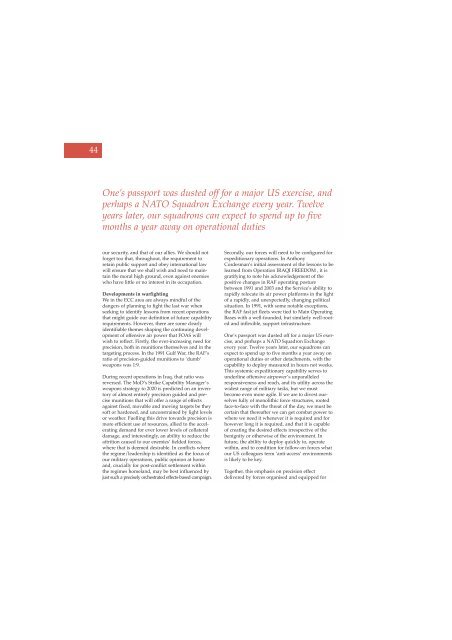Volume 6 No 4 - Royal Air Force Centre for Air Power Studies
Volume 6 No 4 - Royal Air Force Centre for Air Power Studies
Volume 6 No 4 - Royal Air Force Centre for Air Power Studies
You also want an ePaper? Increase the reach of your titles
YUMPU automatically turns print PDFs into web optimized ePapers that Google loves.
44<br />
One’s passport was dusted off <strong>for</strong> a major US exercise, and<br />
perhaps a NATO Squadron Exchange every year. Twelve<br />
years later, our squadrons can expect to spend up to five<br />
months a year away on operational duties<br />
our security, and that of our allies. We should not<br />
<strong>for</strong>get too that, throughout, the requirement to<br />
retain public support and obey international law<br />
will ensure that we shall wish and need to maintain<br />
the moral high ground, even against enemies<br />
who have little or no interest in its occupation.<br />
Developments in warfighting<br />
We in the ECC area are always mindful of the<br />
dangers of planning to fight the last war when<br />
seeking to identify lessons from recent operations<br />
that might guide our definition of future capability<br />
requirements. However, there are some clearly<br />
identifiable themes shaping the continuing development<br />
of offensive air power that FOAS will<br />
wish to reflect. Firstly, the ever-increasing need <strong>for</strong><br />
precision, both in munitions themselves and in the<br />
targeting process. In the 1991 Gulf War, the RAF’s<br />
ratio of precision-guided munitions to ‘dumb’<br />
weapons was 1:9.<br />
During recent operations in Iraq, that ratio was<br />
reversed. The MoD’s Strike Capability Manager’s<br />
weapons strategy to 2020 is predicted on an inventory<br />
of almost entirely precision guided and precise<br />
munitions that will offer a range of effects<br />
against fixed, movable and moving targets be they<br />
soft or hardened, and unconstrained by light levels<br />
or weather. Fuelling this drive towards precision is<br />
more efficient use of resources, allied to the accelerating<br />
demand <strong>for</strong> ever lower levels of collateral<br />
damage, and interestingly, an ability to reduce the<br />
attrition caused to our enemies’ fielded <strong>for</strong>ces,<br />
where that is deemed desirable. In conflicts where<br />
the regime/leadership is identified as the focus of<br />
our military operations, public opinion at home<br />
and, crucially <strong>for</strong> post-conflict settlement within<br />
the regimes homeland, may be best influenced by<br />
just such a precisely orchestrated effects-based campaign.<br />
Secondly, our <strong>for</strong>ces will need to be configured <strong>for</strong><br />
expeditionary operations. In Anthony<br />
Cordesman’s initial assessment of the lessons to be<br />
learned from Operation IRAQI FREEDOM , it is<br />
gratifying to note his acknowledgement of the<br />
positive changes in RAF operating posture<br />
between 1991 and 2003 and the Service’s ability to<br />
rapidly relocate its air power plat<strong>for</strong>ms in the light<br />
of a rapidly, and unexpectedly, changing political<br />
situation. In 1991, with some notable exceptions,<br />
the RAF fast jet fleets were tied to Main Operating<br />
Bases with a well-founded, but similarly well-rooted<br />
and inflexible, support infrastructure.<br />
One’s passport was dusted off <strong>for</strong> a major US exercise,<br />
and perhaps a NATO Squadron Exchange<br />
every year. Twelve years later, our squadrons can<br />
expect to spend up to five months a year away on<br />
operational duties or other detachments, with the<br />
capability to deploy measured in hours not weeks.<br />
This systemic expeditionary capability serves to<br />
underline offensive airpower’s unparalleled<br />
responsiveness and reach, and its utility across the<br />
widest range of military tasks, but we must<br />
become even more agile. If we are to divest ourselves<br />
fully of monolithic <strong>for</strong>ce structures, rooted<br />
face-to-face with the threat of the day, we must be<br />
certain that thereafter we can get combat power to<br />
where we need it whenever it is required and <strong>for</strong><br />
however long it is required, and that it is capable<br />
of creating the desired effects irrespective of the<br />
benignity or otherwise of the environment. In<br />
future, the ability to deploy quickly to, operate<br />
within, and to condition <strong>for</strong> follow-on <strong>for</strong>ces what<br />
our US colleagues term ‘anti-access’ environments<br />
is likely to be key.<br />
Together, this emphasis on precision effect<br />
delivered by <strong>for</strong>ces organised and equipped <strong>for</strong>
















